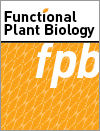Ver ítem
- xmlui.general.dspace_homeCentros e Institutos de InvestigaciónCIAP. Centro de Investigaciones AgropecuariasInstituto de Fisiología y Recursos Genéticos VegetalesArtículos científicosxmlui.ArtifactBrowser.ItemViewer.trail
- Inicio
- Centros e Institutos de Investigación
- CIAP. Centro de Investigaciones Agropecuarias
- Instituto de Fisiología y Recursos Genéticos Vegetales
- Artículos científicos
- Ver ítem
Negative short-term salt effects on the soybean–Bradyrhizobium japonicum interaction and partial reversion by calcium addition
Resumen
The short-term (2 h) effects of salt stress (50 and 150 mM NaCl) on early events of soybean– Bradyrhizobium japonicum (rhizobia) interaction were analysed, determining the following parameters in root hair with or without calcium addition: deformation, apoplastic superoxide radical production (O2⚫–), root hair death and sodium/potassium ion content. We also analysed whether this short-term salt stress influenced later formation of crown and noncrown
[ver mas...]
The short-term (2 h) effects of salt stress (50 and 150 mM NaCl) on early events of soybean– Bradyrhizobium japonicum (rhizobia) interaction were analysed, determining the following parameters in root hair with or without calcium addition: deformation, apoplastic superoxide radical production (O2⚫–), root hair death and sodium/potassium ion content. We also analysed whether this short-term salt stress influenced later formation of crown and noncrown nodules, determining the number and weight of nodules. The negative effect of salt stress on these characters was attenuated by the addition of 5 mM CaCl2. We also analysed the expression of pathogenesis-related proteins (PRP) genes PR-1, PR-2, PR-3, and four isoforms of PR-5. The expression of PR-2 increased under saline conditions and decreased in osmotic treatment and saline treatment supplemented with calcium in the presence of the symbiont. The changes in PR-2 expression levels, together with the death of root hairs provide a possible mechanism for the inhibition of infection by the symbiont under salinity, and suggests a possible overlap with responses to plant pathogens.
[Cerrar]

Fuente
Functional Plant Biology 41 (1) : 96-105 ( 2013)
Fecha
2013-09-05
Editorial
CSIRO Publishing
ISSN
1445-4408
1445-4416 (online)
1445-4416 (online)
Formato
pdf
Tipo de documento
artículo
Palabras Claves
Derechos de acceso
Restringido
 Excepto donde se diga explicitamente, este item se publica bajo la siguiente descripción: Creative Commons Attribution-NonCommercial-ShareAlike 2.5 Unported (CC BY-NC-SA 2.5)
Excepto donde se diga explicitamente, este item se publica bajo la siguiente descripción: Creative Commons Attribution-NonCommercial-ShareAlike 2.5 Unported (CC BY-NC-SA 2.5)

